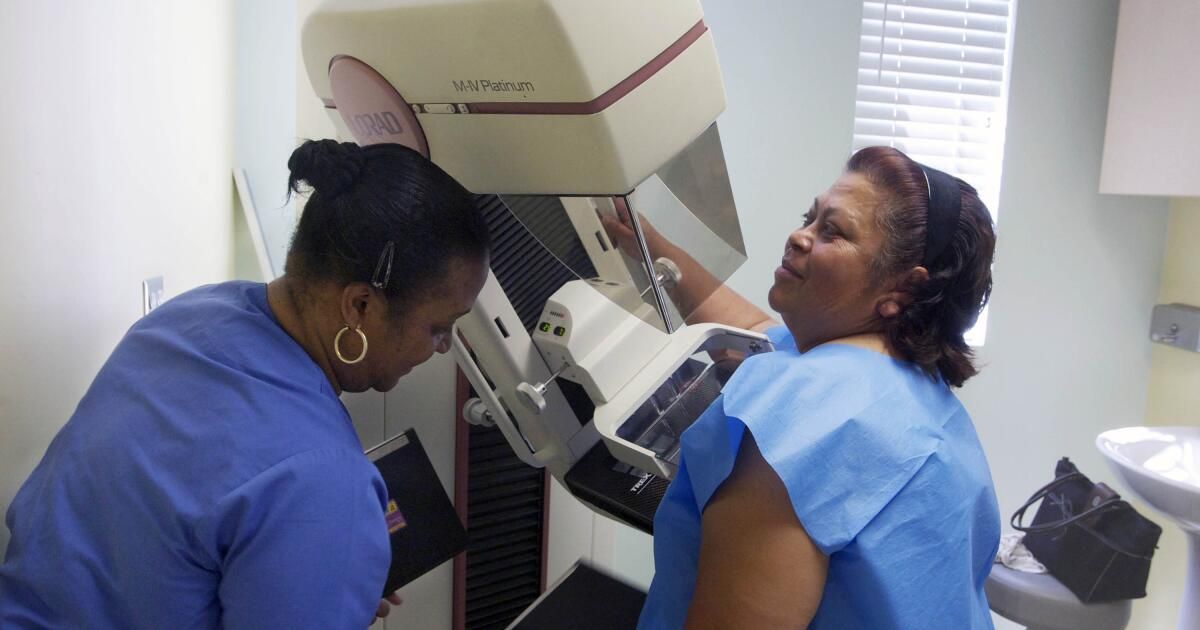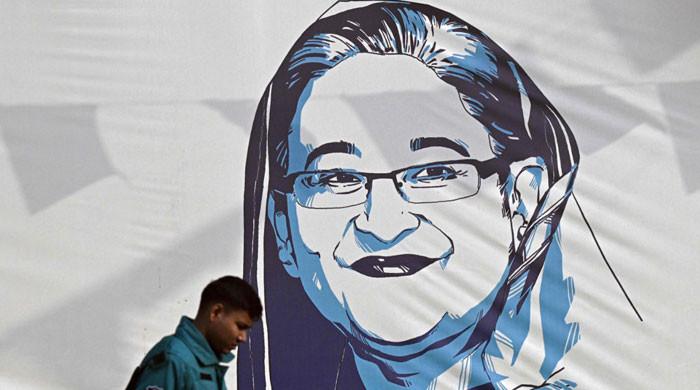To counter rising rates of breast cancer in younger women and reduce racial disparities in deaths, an influential panel has changed its advice and urges most women to start getting regular mammograms at age 40.
New recommendations from the U.S. Preventive Services Task Force say women without genetic mutations that make them extremely likely to develop breast cancer should have their first mammogram to screen for the disease at age 40 and should continue with exams every two years until they turn 74. The guidelines were published Tuesday in the Journal of the American Medical Assn.
Breast cancer is one of the most common cancers among women in the US, as well as one of the deadliest. An estimated 297,790 American women were diagnosed with the disease last year and 43,170 died from it. according the American Cancer Society.
The task force, a group of 16 experts convened by the federal government, caused a stir 15 years ago when it said women could wait until age 50 to start getting screened for breast cancer every two years, much longer. late and less frequently than other medical groups recommended. At the time. The group's reasoning was that women in their 40s faced a low risk of breast cancer and that frequent testing of asymptomatic women in this age group led many to endure biopsies and other invasive procedures that were unnecessary and potentially dangerous.
The task force reaffirmed its controversial position in 2016. But when it came time to update its guidelines again, two facts stood out.
First, the incidence of invasive breast cancer in younger women, which had been rising slowly since at least 2000, began to accelerate around 2015, increasing by an average of 2% annually over the next four years.
Second, the task force recognized that among all racial and ethnic groups, black women are more likely to be diagnosed with breast cancers that have progressed beyond stage 1, including aggressive “triple negative” tumors that They are particularly difficult to treat. Black women also have the highest mortality rate from breast cancer (about 40% higher than white women) “even accounting for differences in age and stage at diagnosis,” the study wrote. working group at JAMA.
After analyzing data from randomized clinical trials and models based on real-world data, the panel determined that starting biennial mammograms at age 40 instead of 50 would prevent 1.3 additional breast cancer deaths per 1,000 women during the course of their lives. For black women, starting a decade earlier would prevent 1.8 additional deaths per 1,000 women.
“This is a big change, absolutely,” said Dr. Stamatia Destounis, chair of the American College of Radiology's Commission on Breast Imaging. “We all know that if you start examining a woman at age 40, you will find the most cancers.”
Robert Smith, senior vice president of cancer early detection science at the American Cancer Society, said the task force's new guidance is more in line with advice from other medical organizations, including his own.
“We don't want any woman to be diagnosed late with breast cancer if it can be avoided,” Smith said. “There is no substitute for finding breast cancer earlier in its natural history.”
But Ricki Fairley, founder and CEO of Touch, the Black Breast Cancer Alliance in Annapolis, Maryland, said that if the goal is to reduce racial disparities, screening at age 40 and older is not enough.
“Right now I'm dealing with patients who are 24, 23 years old and who have breast cancer and are dying,” said Fairley, a breast cancer survivor who was diagnosed at age 55. “Getting a first mammogram at age 40 is too late for black women.”
Reonna Berry, president and co-founder of the African American Breast Cancer Alliance in Minneapolis, criticized the task force for following her advice to screen every two years.
“If we waited every two years to get a mammogram, a lot of black women would be dead,” said Berry, who was diagnosed with breast cancer at age 38 and again a few years ago, when she was in her 60s.

A radiologist reviews a mammogram at UCLA.
(Jay L. Clendenin / Los Angeles Times)
The American College of Radiology and the Society of Breast Imaging recommend annual screening starting at age 40. The American Cancer Society recommends annual screening for people ages 45 to 54, and then every year or two after that. Additionally, the ACR advises Black women to complete a risk assessment and design a screening strategy with a doctor when they are 25 years old, Destounis said.
Smith said that although black women under 40 are more likely than their white counterparts to be diagnosed with breast cancer, the difference is not large enough to justify widespread screening.
According to data collected by the National Cancer Institute, there are 38 cases of breast cancer per 100,000 black women ages 30 to 34, compared to 32.3 cases per 100,000 white women in the same age group. For women aged 35 to 39, the respective figures are 74.8 and 69.2. In both age groups, that equates to fewer than 6 additional breast cancers per 100,000 women.
Smith and others criticized the task force for not supporting screening mammograms for women over 74. As in previous years, the panel determined that there was not enough evidence to make a recommendation one way or the other.
“At age 75, the risk of breast cancer is very high,” Smith said.
There are 473.2 cases per 100,000 women of all racial and ethnic backgrounds between the ages of 75 and 79, and 425.8 cases between the ages of 80 and 84, the National Cancer Institute reports.
“There is no reason, at least in our view, that women should stop getting screened as long as they are healthy and expect to live another 10 years,” Smith said.
Dr. John B. Wong, vice chair of the task force, said the lack of evidence on mammograms in older women is “totally frustrating.”
There are no randomized clinical trials with women in this age group, but the panel did consider a cohort study of more than 1 million Medicare patients that found no benefit when testing women ages 75 to 84, Wong said.
The situation was similar regarding the use of ultrasound or MRI as complementary screening tools for women with dense breasts, he said.
“We know they are at higher risk and we know that mammography doesn't work as well for them,” Wong said. “We would love to have some evidence to help us decide what to recommend about what they should do.”
Regarding the frequency of examinations, the working group had sufficient data to act. With biennial screening between ages 40 and 74, there will be about 1,376 false-positive results per 1,000 women over their lifetime, along with 14 cases in which doctors will find and treat early-stage tumors that perhaps they would never have become dangerous if left alone. Both would increase by about 50% if women were screened annually, Wong said.
The panel concluded that screening every two years prevents more deaths and results in more years of life gained from mammography, producing a better balance between benefits and harms.
Dr. Julie Gralow, medical director of the American Society of Clinical Oncology, said she would weigh those trade-offs differently.
“As a breast cancer doctor, I'm on the receiving end of everyone diagnosed and I think they exaggerated the harms versus the benefits,” she said, particularly the anxiety that would arise if I were asked to come in for a follow-up. Upload images. “I know for some women that's very scary and all, but it's almost a paternalistic view.”
Karen Eubanks Jackson, founder and CEO of Sisters Network, a national breast cancer organization for Black women, echoed that idea.
“We understand that having too many mammograms can sometimes be unfavorable,” said Jackson, a breast cancer survivor. “But as a black woman who's had it four times, I'd rather give a false positive than be positive and not know it. Give me my choice.”
Gralow emphasized that the task force's recommendations do not apply to women with any type of breast abnormality.
“If you have any symptoms, then you should go directly to the diagnosis, and that should be done at any age,” he said.
In Smith's ideal world, precision medicine would allow doctors to replace blanket guidelines with individualized screening recommendations based on information in each woman's medical records.
“They might say, 'Start testing at a younger age,' or 'Test every year,' or 'You can do it every two years, and that's just as safe,'” Smith said. “The sooner we move in that direction, the better.”












